maintenance AUDI A5 COUPE 2011 Owners Manual
[x] Cancel search | Manufacturer: AUDI, Model Year: 2011, Model line: A5 COUPE, Model: AUDI A5 COUPE 2011Pages: 362, PDF Size: 84.88 MB
Page 5 of 362
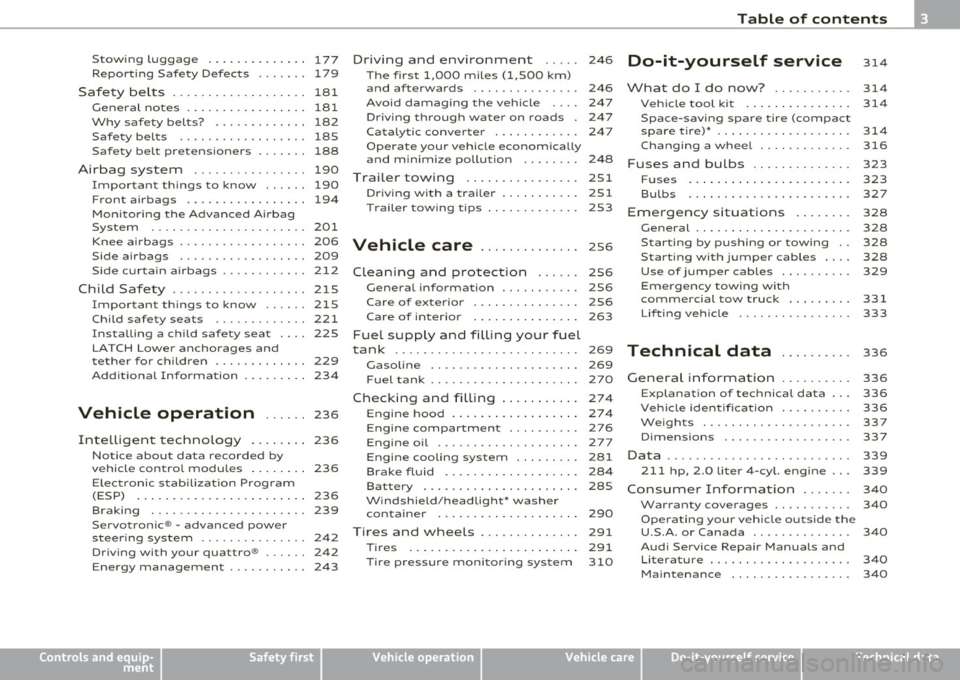
Stowing Luggage ........... ... 177
Repor ting Safe ty Defects . . . . . . . 179
Safety be lts . . . . . . . . . . . . . . . . . . . 181
General no tes ........ ......... 181
Why safety belts? . . . . . . . . . . . . . 182
Safety belts . . . . . . . . . . . . . . . . . . 185
Safety belt pretensioners . . . . . . . 188
Airbag system ................ 190
Important th ings to know ...... 190
Front airbags ................. 194
Mon ito ring the Advanced A irbag
System ...................... 201
Knee ai rbags . . . . . . . . . . . . . . . . . . 206
Side airbags . . . . . . . . . . . . . . . . . . 209
Side curtain airbags ......... ... 212
Chil d Safe ty ................... 215
I mportant things to know ...... 215
Child safety seats ............. 221
Installing a child safety seat . . . . 225
LATCH Lowe r ancho rages and
tether for children . . . . . . . . . . . . . 229
Add it ional Informat ion
234
Vehicle operation ...... 236
Intelligent technology . . . . . . . . 236
Notice abo ut data recorded by
vehicle contro l modu les . . . . . . . . 236
E lect ronic s tab iliza tion Program
(ESP) . . . . . . . . . . . . . . . . . . . . . . . . 236
Braking ...................... 239
Servotronic ® -advanced power
steer ing sys tem . . . . . . . . . . . . . . . 242
Dr iving with your quattro ® . . . . . . 242
Energy management . . . . . . . . . . . 243
Controls and equip
ment Safety first
Driving
and environment ..... 246
The first 1,000 miles (1,500 km)
and afterwards . . . . . . . . . . . . . . . 246
Avoid damaging the vehicle 247
Dr iving through water on roads . 247
Ca talytic conve rter . . . . . . . . . . . . 247
Operate your veh icle economica lly
and m inimize po llution . . . . . . . . 24 8
Trailer towing . . . . . . . . . . . . . . . . 251
Dr iving wi th a trailer . . . . . . . . . . . 251
T railer tow ing tips . . . . . . . . . . . . . 253
Vehicle care .............. 2s6
Clea nin g and protect ion ...... 256
General information . . . . . . . . . . . 256
Care of exterior . . . . . . . . . . . . . . . 256
Care of interior . . . . . . . . . . . . . . . 263
Fuel supply and filling your fuel
tank .......................... 269
Gasol ine . . . . . . . . . . . . . . . . . . . . . 269
F u el tank .................... . 270
Checking and filling . . . . . . . . . . . 274
Eng ine hood . . . . . . . . . . . . . . . . . . 274
Engine compartment . . . . . . . . . . 276
Engine oil . . . . . . . . . . . . . . . . . . . . 277
Engine cooling system . . . . . . . . . 281
Brake fluid . . . . . . . . . . . . . . . . . . . 284
Bat tery . . . . . . . . . . . . . . . . . . . . . . 285
W indshield/headlight* washer
container . . . . . . . . . . . . . . . . . . . . 290
Tires and wheels .............. 291
Tires 291
T ir e pressure monitor ing system 310
Table of contents
Do-it-yourself service
What do I do now? .......... .
Vehic le tool k it ........ ...... .
Space -saving spare tire (compact
spare tire)* ....... ........ ... .
Cha nging a whee l ........... . .
Fuses and bulbs ......... .... .
Fu ses ... ......... .......... .
Bulbs ...................... .
Emergency situations ....... .
General . ........... ......... .
Starti ng by pushing or towi ng ..
Starting with jumper cables ... .
Use of jumper cables ......... .
Emergency towing w ith
commercial tow truck ........ .
Lif ting vehicle ............... .
Technical data
General information
Explana tion of technica l da ta .. .
Vehicle ident ification ......... .
Weights .................... .
Dimensions ................. .
Data ................ ... ...... .
211 hp, 2.0 Liter 4-cyl. engine .. .
Consumer Information ...... .
Warranty coverages .......... .
Operating your vehicle outside the
U.S.A . or Canada ............. .
Audi Service Repair Manuals and
Literature ................... .
Maintenance ............... . . 314
314
314
314
316
323
323
327
328
328
328
328
329
331
333
336
336
336
336
337
337
339
339
340
340
340
340
340
Vehicle operation
Vehicle care Do-it-yourself service Technical data
Page 7 of 362
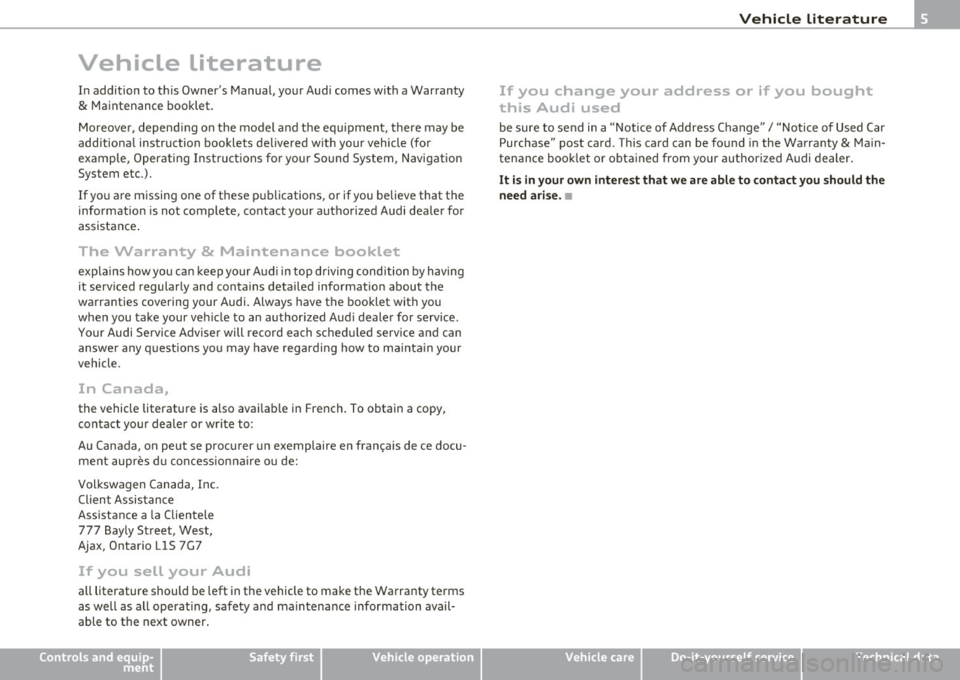
Vehicle literature
In addition to this Owner's Manual, your Audi comes with a Warranty
& Ma intenance booklet.
Moreover, depend ing on the model and the equ ipment, there may be
additional instruction booklets de livered with your vehicle (for
example, Operating Instruct ions fo r you r Sound System , Navigat ion
System etc .) .
If yo u are missing one of these publications, or if you believe that the
information is not complete, contact your authorized Audi deale r for
assistance .
The Warranty & Maintenance booklet
expla in s how you can keep your Audi in top driving condition by having
it serviced regularly and conta ins detailed informat ion about the
warranties covering your Audi. Always have the booklet with you
when you take your veh icle to an author ized A udi dealer for service .
Your Audi Service Adviser will record each sched uled service and can
answe r any q uestions you may have regarding how to ma inta in your
vehicle.
In Canada,
the vehicle literature is also avai lab le in French . To obtain a copy,
contact you r dealer or write to :
Au Canada, on peut se procurer un exemplaire en fran~ais de ce docu
ment aupres du con cession na ire o u de:
Volkswagen Canada, Inc. Client Assistance
Assistance a la Cliente le
777 Bayly St reet, West,
Ajax, Ontario LlS 7G7
If you sell your Audi
all literature should be left in the vehicle to make the Warranty terms
as well as all operat ing, safety and ma intenance information avail
able to the next owner .
Controls and equip
ment Safety first Vehicle operation
Vehicle Literature
If you change your address or if you bought
this Audi used
be sure to send in a "Notice of Address Change" I "Notice of Used Car
Purchase" post card. This card can be found in the Warranty
& Main
tenance boo klet o r obta ined from your authorized Audi dealer.
It is in your own int ere st that we a re a ble to contact you should the
n eed arise .•
Vehicle care Do-it-yourself service Technical data
Page 103 of 362
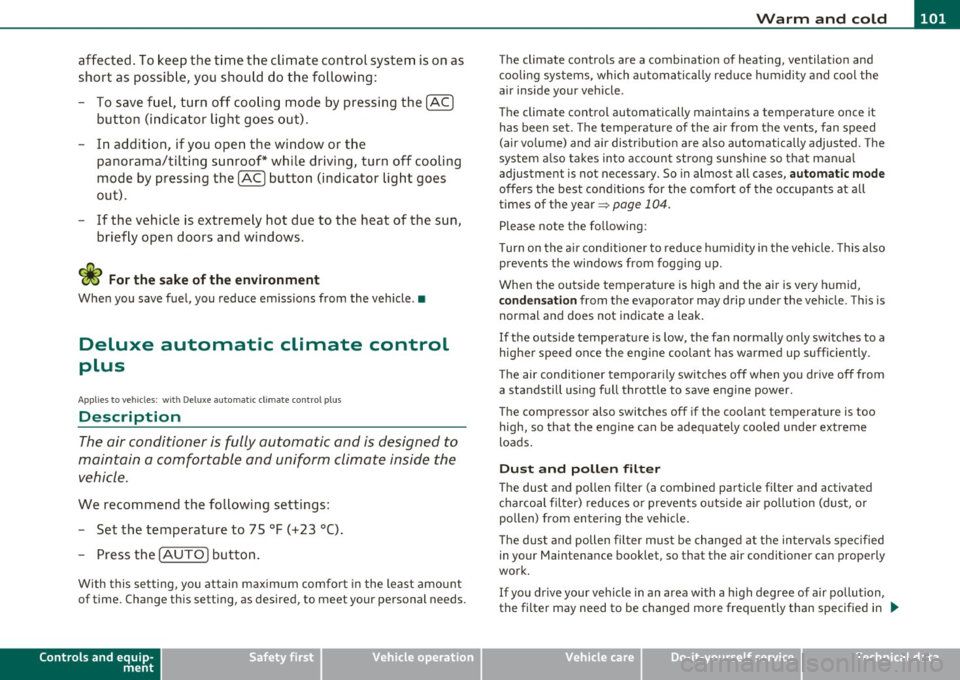
_________________________________________________ w __ a _r _m __ a_n _d_ c_ o_ ld __ _
affected . To keep the time the climate control system is on as
short as possible, you should do the following:
- To save fuel, turn off cooling mode by pressing the
[AC)
button (indicator light goes out) .
- In addition, if you open the window or the
panorama/tilting sunroof* while driving, turn off cooling
mode by pressing the
[AC) button (indicator light goes
out).
- If the vehicle is extremely hot due to the heat of the sun,
briefly open doors and windows.
~ For the sake of th e environm ent
When you save fuel, you reduce emissions from the vehicle .•
Deluxe automatic climate control
plus
App lies to veh icles: w ith De luxe automatic climate control plus
Description
The air conditioner is fully automatic and is designed to
maintain a comfortable and uniform climate inside the
vehicle.
We recommend the following settings:
- Set the temperature to 75 °F (+23 °C).
- Press the
[AUTO) button.
With this setting, you attain maximum comfort in the least amount
of time. Change this setting, as desired, to meet your personal needs.
Controls and equip
ment Safety first
The climate controls are a combination
of heating, ventilation and
coo ling systems, which automatically red uce humidity and cool the
air inside your vehicle .
The climate control automatically maintains a temperature once it
has been set. The temperature of the air from the vents, fan speed
(air volume) and air distribution are also automatically adjusted. The
system a lso takes into account strong sunsh ine so that man ual
adjustment is not necessary. So in almost all cases,
automa tic mo de
offers the best condit ions for the comfort of the occupants at all
times of the year~
page 104.
Please note the following:
T urn on the a ir cond itioner to reduce humidity in the vehicle. This also
prevents the windows from fogging up.
When the outside temperature is high and the air is very humid,
condensati on from the evaporator may drip under the vehicle. This is
normal and does not indicate a leak .
If the outside temperature is low, the fan normally only switches to a
higher speed once the engine coolant has warmed up sufficiently.
T he air conditioner temporari ly switches off when you drive off from
a standstill using full throttle to save engine power.
T he compressor also switches off if the coolant temperature is too
high, so that the engine can be adequately cooled under extreme
loads.
Du st a nd p ollen filt er
The dust and pollen filter (a combined particle fi lter and activated
charcoal filter) reduces or prevents outside a ir po llution (dust, or
pollen) from entering the vehicle.
T he dust and pollen filter must be changed at the intervals specified
in your Maintenance booklet, so that the air conditioner can properly
work.
If you drive your vehicle in an area with a high degree of air pollution,
the filter may need to be changed more frequently than specified in .,.
Vehicle care Technical data
Page 104 of 362

1111....__w __ a _r_ m __ a_n_ d_ c_ o _ l_d _______________________________________________ _
your Audi Warranty & Maintenance book let . If in doubt, as k yo ur
a u tho rized Au di Serv ice Advisor for adv ice.
Key recognit ion
T he cur rent climate con trol settings are au tom atically s tored and
assigned to the remote key
Energy management
To prevent the battery from being discharged and to restore the
balance of energy, components wh ic h require large amo unts of
energy are temporarily cut back or sw itched off=>
page 243. Heating
systems in part icu lar req uire a g rea t dea l of energy. If you notice, for
example, that the rear window heater is not heating, then it has been
temporar ily c ut back or switched off by
ene rg y management. These
systems are available again as soon as the energy balance has been
restored .
& WARNING
Reduce d vi sibility is danger ous and can cause a ccident s.
• For safe dri ving it is very important that all windows be free of
ic e, snow and condensation .
• Completely fam iliar ize yourself with the prope r use and func
tion of th e heating and v entilation sy stem and esp eciall y how to
defog and defro st the w indows .
• Never use the wind shield wiper /wa sher system in fr eezing
we ather until you h ave warmed the windshield fir st, u sing the
heating and ventila tion syst em . The wa sher solution ma y free ze
on the win d shield and reduce visi bility.
0 Note
• If you suspect that the cl imate contro l system has been damaged,
switch the system off to avoid further damages, and have i t inspected
by a qua lified dealersh ip. •
Repairs to the Audi a ir conditioner require special techn ica l knowl
edge and special tools . Co ntact an a uth orized Audi dealer fo r assis
tance .
(I] Tips
• To avoid adversely affecting heating and cooling performance and
to prevent condensation on the windows, the air intake in front of the
w indshield must be free of ice, snow and leaves.
• Th e air flowing out of the vents and througho ut the veh icle's
entire inter ior is discharged at the rea r of the vehicle . Make su re that
the o utlet s lots are not covered by clothing, etc.
• Climate control works most effective ly if the windows and the
panoramic sliding/tilt ing sunroof * are closed. However, if the interior
of a parked vehicle is extremely hot from the sun, briefly opening the
windows can speed up the cooling process. •
Page 207 of 362
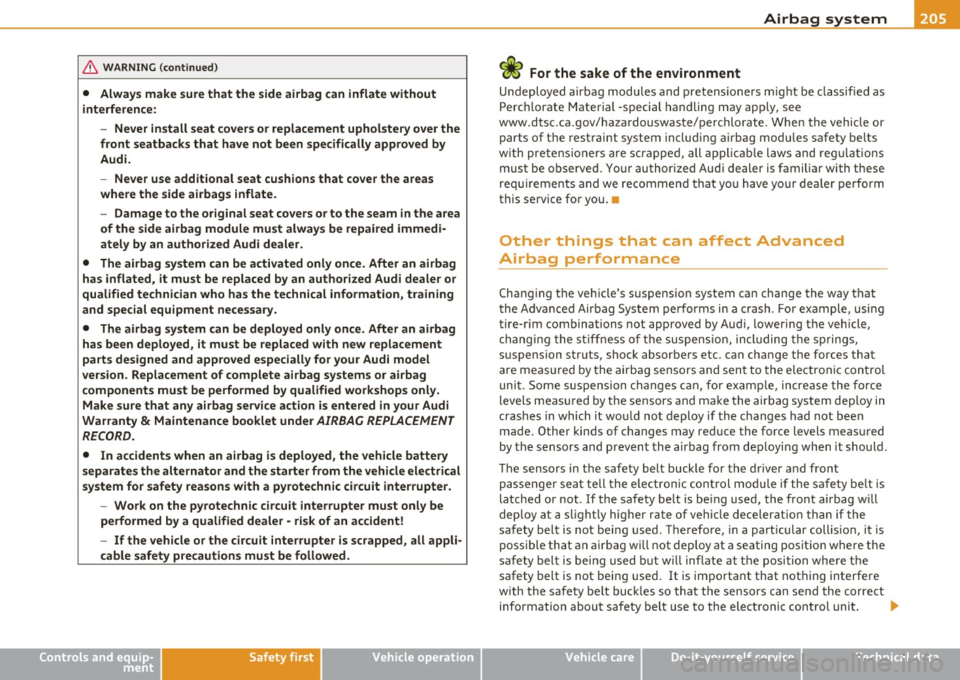
______________________________________________ ___:.A:::::.:.: ir:....: b~ a~g !....= s:ly '..:s~ t~ e~ m~ ---
& WARNING (co ntinued )
• Always make sure that the side airbag can inflate without
interference:
-Never install se at covers or replacement upholstery over the
front seatbacks that have not been specifically approved by
Audi .
- Never use additional seat cushions that cover the areas
where the side airbags inflate .
- Damage to the original seat covers or to the seam in the area
of the side airbag module must always be repaired immedi
ately by an authorized Audi dealer.
• The airbag sy stem can be activated only once. After an airbag
has inflated, it must be replaced by an authorized Audi dealer or
qualified technician who has the technical information , training
and special equipment necessary.
• The airbag sy st e m can be deployed only onc e. After an airbag
has been deployed, it must be replaced w ith new replacement
parts de signed and approved es pecially for your Audi model
version . Replacement of complete airbag systems or airbag
components must be performed by qualified workshops only.
Make sure that any airbag service action is entered in your Audi
Warranty
& Maintenance booklet under AIRBAG REPLACEMENT
RECORD.
• In accidents when an airbag is deployed, the vehicle battery
separates the alternator and the starter from the vehicle electrical
system for safety reason s with a pyrotechnic circuit interrupter.
- Work on the pyrotechnic circu it interrupter must only be
performed by a qualified dealer -risk of an a ccident!
- If the vehicle or the circu it interrupter is scrapped, all appli
cable safety precautions must be followed .
Controls and equip ment Safety first Vehicle operation
'£' For the sake of the environment
U
ndeployed airbag modules and pretens io ners mig ht be classified as
Perch lorate Material -special handling may app ly, see
www.d ts c. ca.gov/ha za rdouswaste/pe rchlorate . W he n t he vehicle or
parts of the restraint system includi ng a irbag modules safety belts
w ith pretens io ners are s crappe d, all ap plic abl e laws and reg ulat ion s
must be observed. Your author ized Aud i dealer is familiar with these
req uir ements and we recommen d that yo u have yo ur dea le r pe rform
this service for you .•
Other things that can affect Advanced
Airbag performance
Chang ing the ve hicle's suspension system can change the way that
t he Adv anced Airbag System pe rforms in a crash . For example, using
tire-r im combinations not approved by Aud i, lower ing the veh icle,
c hang ing the st iffness o f the suspe nsio n, incl uding the s prings,
s u spension str uts, shoc k absorbe rs etc. can change the forces that
are meas ured by the airb ag sensors and sen t to the ele ctron ic con trol
uni t. Some suspension changes ca n, for examp le, increase the force
levels measu red by t he sensors and ma ke the airbag system dep loy in
crashes in which it wou ld not deploy if the changes had not bee n
made . Other kin ds of changes may re duce the force levels meas ured
by the senso rs and p revent the airbag from dep loyi ng when it should .
The sensors in the safety belt buckle for the d river and front
p assenger se at tell the e le ct ro nic co ntro l mo dule if the sa fe ty belt is
latc hed or not . If the safety be lt is be ing used, the fron t airbag w ill
dep loy at a s ligh tly hig her ra te o f ve hicl e decelerat io n t han if the
safety belt is not be ing used. T he refo re, in a part icular collis io n, it is
poss ible that an a irbag wi ll not deploy at a seating posit ion where the
safety belt is being used but wi ll inflate at the posi tion whe re the
safety belt is not bei ng used. It is important that not hing interfere
w ith the s afe ty be lt bu ckles so t hat th e sensor s can sen d the correct
information about safety belt use to the electronic contro l unit. ..
Vehicle care Do-it-yourself service Technical data
Page 250 of 362
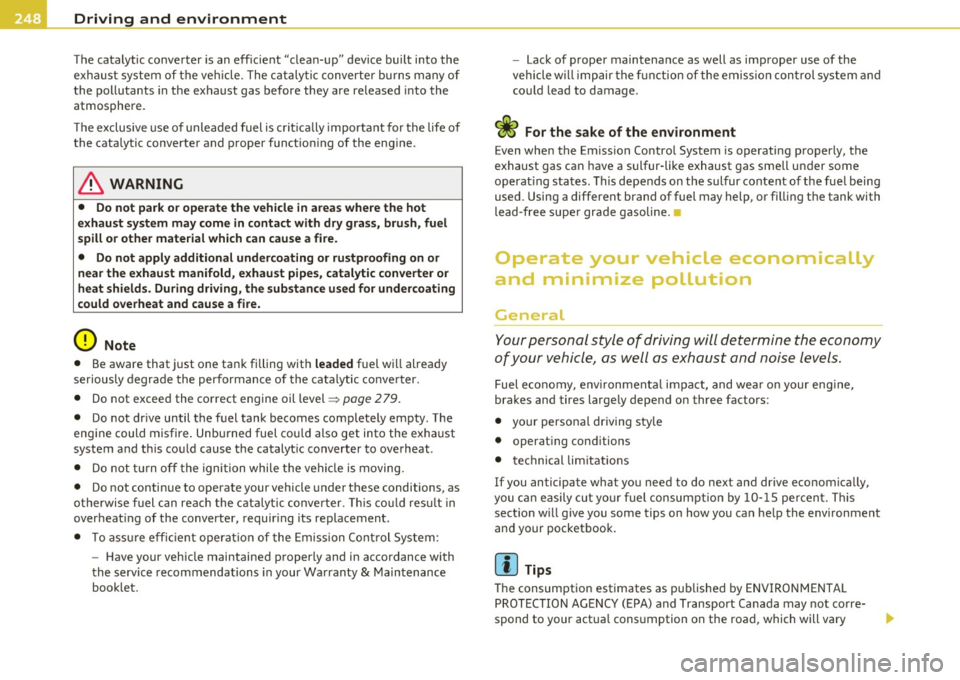
Driving and environment
The catalytic converter is an effic ient ''clean-up" dev ice built into the
ex hau st system of the ve hicle. The c ata ly tic converter bu rns many of
the pollutants in the exhaust gas before they are released into the
atmosphere.
T he exclusive use of unleaded fuel is c rit ical ly import ant for the life of
the cata lytic converter and proper funct ioning of the eng ine.
& WARNING
• Do not park or operate the vehicle in areas where the hot
e xhaust system may come in contact with dry grass, brush, fuel
spill or other material which can cause a fi re.
• Do not apply additional undercoating or rustproofing on or
near the e xhaust man ifold , exhaust pipes , catalytic converte r or
heat shields . During driving, the substance used for undercoating
could overheat and cause a fire.
0 Note
• Be aware that j ust one tank filling with leaded fuel will already
seriously degrade the performance of the ca talytic conve rter.
• Do not exceed the correct engine oil level =>
page 279.
• Do not dr ive until the fuel tan k becomes complete ly empty . The
engine could misfire . Unburned fuel cou ld also get into the exha ust
system and th is cou ld cause the catalyt ic converter to overheat .
• Do not tu rn o ff the igni tion while t he vehi cle is moving.
• Do not contin ue to operate your vehicle under these conditions, as
otherwi se fuel c an reac h the c atal ytic conve rter. This co uld res ult in
overheat ing of the converter, requir ing its replacement.
• T o ass ure eff icient ope ra ti on of the Emiss ion Cont rol System:
- Have your vehicle maintained properly and in accordance with
the se rvice recommendations in your Wa rranty
& M aintenance
booklet. -
Lack of proper maintenance as well as improper use of the
veh icle w ill impair the f unc tion of the emiss io n con trol sys te m an d
co uld lead to damage.
<£> For the sake of the environment
Even when the Emiss ion Control System is operating p roperly, the
exhaust gas can have a s ulfur -like exhaust gas smell under some
operat ing states . This depends on the sulfur content of the fu el being
used. Using a different brand of fuel may help, or filling the tank with
lead -free supe r grade gasoline. •
Operate your vehicle economically
and minimize pollution
General
Your personal style of d riving will det ermine the economy
of your vehicle, as well as exhaust and noise le vels.
Fuel eco nomy, e nvir onmenta l impa ct, and wea r o n your eng ine ,
brakes and tires large ly depend on three factors:
• your persona l driving style
• operat ing cond itions
• t echni cal lim itat io ns
If you anticipate what you need to do next and drive economica lly,
you c an easily cut yo ur fuel consum ptio n by 10- 15 pe rcen t. T his
sect io n w ill give you some tips on how you can he lp the env ironment
and your pocket book.
[ i ] Tips
Th e consumption estimates as pub lished by ENV IRONMENTAL
PROTECTIO N AG ENCY ( EPA) and Transport Ca nada may not co rre
spond to your act ua l cons umption on the road, which will vary
Page 251 of 362
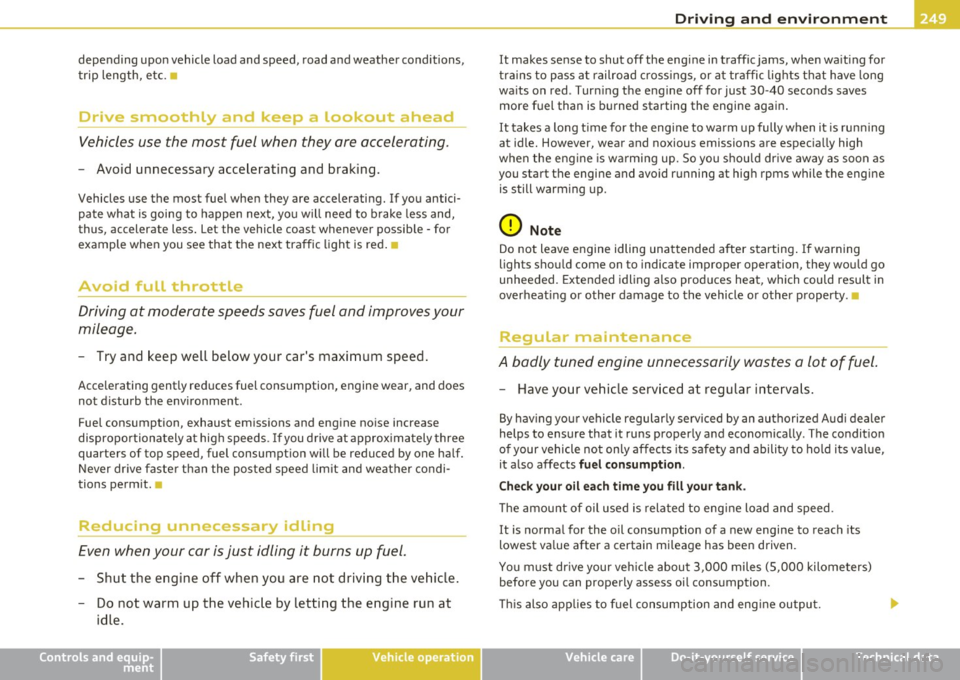
Driving and environment
------------------------------------------------'
depending upon vehicle load and speed, road and weather conditions,
trip length, etc. •
Drive smoothly and keep a lookout ahead
Vehicles use the most fuel when they are accelerating .
-Avoid unnecessary accelerating and braking.
Vehicles use the most fuel when they are accelerating. If you antici
pate what is going to happen next, you will need to brake less and,
thus, accelerate less. Let the vehicle coast whenever possible - for
example when you see that the next traffic light is red.
Avoid full throttle
Driving at moderate speeds saves fuel and improves your
mileage.
- Try and keep well below your car's maximum speed.
Accelerating gently reduces fuel consumption, engine wear, and does
not disturb the environment .
Fuel consumption, exhaust emissions and eng ine noise increase
disproportionately at high speeds . If you drive at approximately three
quarters of top speed, fuel consumption will be reduced by one half.
Never drive faster than the posted speed limit and weather condi
tions permit. •
Reducin~ unnecessary idling
Even when your car is just idling it burns up fuel.
-Shut the engine off when you are not driving the vehic le .
- Do not warm up the vehicle by letting the engine run at
idle.
Controls and equip ment Safety first Vehicle operation It makes sense to shut off the engine in traffic jams, when waiting for
trains to pass at railroad crossings, or at traffic lights that have long
waits on red. Turning the engine off for just 30 -40 seconds saves
more fuel than is burned starting the engine again .
It takes a long t ime for the engine to warm up fully when it is running
at idle. However, wear and noxious emissions are especia lly high
when the eng ine is warming up. So you should dr ive away as soon as
you start the engine and avoid running at high rpms while the engine
is still warming up.
0 Note
Do not leave engine idling unattended after starting . If warning
lights should come on to indicate improper operation, they would go
unheeded. Extended idling also produces heat, which could result in
overheat ing or other damage to the vehicle or other property. •
Regular maintenance
A badly tuned engine unnecessarily wastes a lot of fuel .
- Have your vehic le serviced at regular intervals .
By having your vehicle regularly serviced by an authorized Audi dealer
helps to ensure that it runs properly and economically . The condit ion
of your vehicle not on ly affects its safety and ability to hold its val ue,
it also affects fuel consumption.
Check your oil each time you fill your tank.
Th e amount of oil used is related to engine load and speed.
It is normal for the oil consumption of a new engine to reach its
lowest value after a certain mileage has been driven.
You must dr ive your veh icle about 3,000 miles (5,000 kilometers)
before you can properly assess oi l consumption .
Thi s also applies to fuel consumption and eng ine output.
Vehicle care Do-it-yourself service Technical data
Page 252 of 362
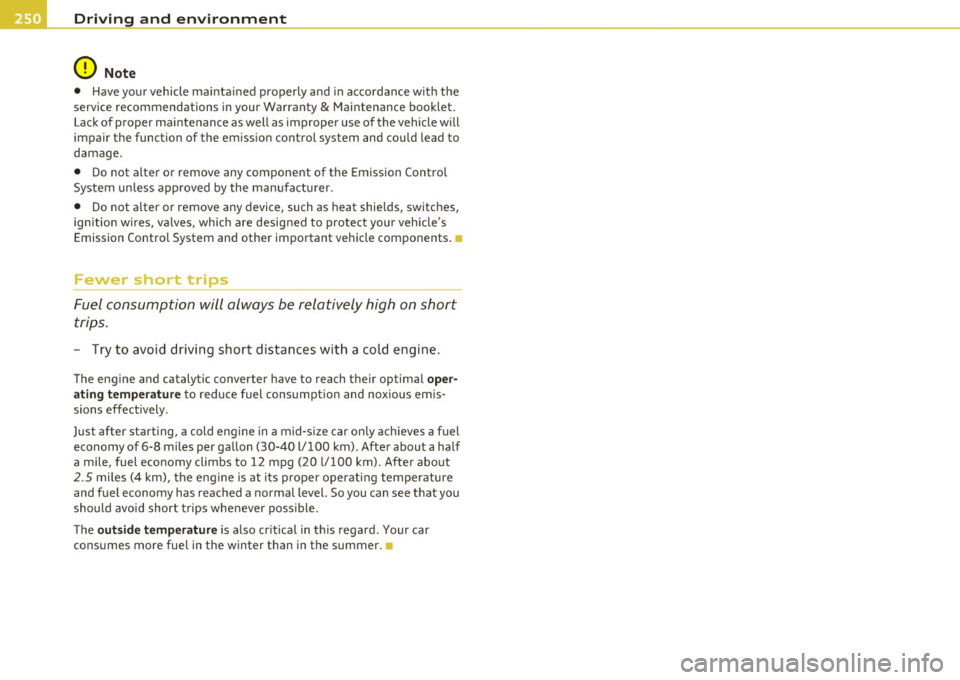
Driving and environment
0 Note
• Have your vehicle mainta ined properly and in accordance w ith the
service recommendations in your Warranty
& Maintenance booklet.
Lack of proper maintenance as well as improper use of the vehicle w ill
impair the function of the emission control system and could lead to
damage.
• Do not alter or remove any component of the Emission Control
System unless approved by the manufacturer.
• Do not a lter or remove any device, such as heat shields, switches,
ignition w ires, va lves, which are designed to protect your vehicle 's
Emission Control System and other important vehicle components .•
Fewer short trips
Fuel consumption will always be relatively high on short
trips .
-Try to avoid driving short distances with a cold engine.
The engine and catalytic converter have to reach their optimal oper
ating temperature
to reduce fuel consumption and noxious emis
sions effectively.
Just after starting, a cold engine in a mid-size car only achieves a fuel economy of 6-8 miles per ga llon (30-40 l/100 km). After about a half
a mile, fuel economy climbs to 12 mpg (20 l/100 km). After about
2.5 miles (4 km), the engine is at its proper operating temperature
and fuel economy has reached a normal level. So you can see that you
sho uld avoid short trips whenever poss ible.
The
outside temperature is also cr it ical in this regard . Your car
consumes more fue l in the winter than in the summer.
Page 279 of 362
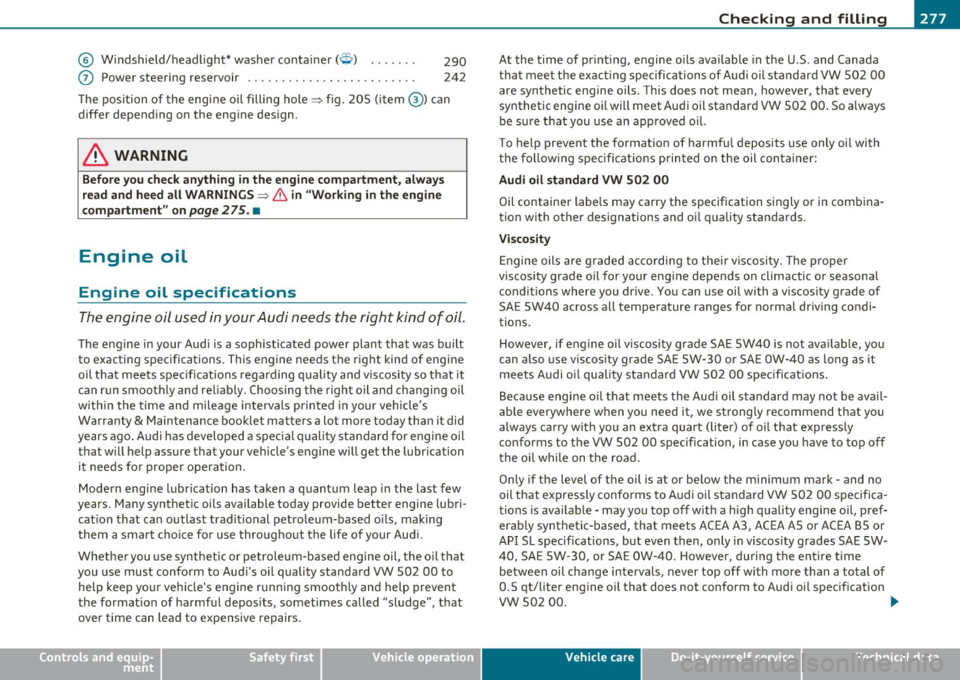
___________________________________________ C_ h_e _c _k_ i_n ~g_ a_n_ d_ f_ i_ll _i_n _g __ ,n
© Windshield/headlight* washer container (W ) . . . . . . . 290
(J) Power steering reservoir . . . . . . . . . . . . . . . . . . . . . . . . . 242
The position of the engine oil filling hole=:> fig. 205 (item@) can
differ depending on the engine design .
& WARNING
Before you check anything in the engine compartment, always
read and heed all WARNINGS=:>
& in "Working in the engine
compartment" on
page 275. •
Engine oil
Engine oil specifications
The engine oil used in your Audi needs the right kind of oil.
The engine in your Audi is a sophisticated power plant that was built
to exacting specifications. This engine needs the right kind of engine
oil that meets specifications regarding quality and viscosity so that it
can run smoothly and reliably. Choosing the right oil and changing oil
within the time and mileage intervals printed in your vehicle's
Warranty
& Maintenance booklet matters a lot more today than it did
years ago. Audi has developed a special quality standard for engine oil
that will help assure that your vehicle's engine will get the lubrication
it needs for proper operation.
Modern engine lubrication has taken a quantum leap in the last few
years. Many synthetic oils available today provide better engine lubri
cation that can outlast traditional petroleum-based oils, making
them a smart choice for use throughout the life of your Audi.
Whether you use synthetic or petroleum-based engine oil, the oil that
you use must conform to Audi's oil quality standard VW 502 00 to help keep your vehicle's engine running smoothly and help prevent
the formation of harmful deposits, sometimes called "sludge", that
over time can lead to expensive repairs.
Safety first
At the time of printing, engine oils available in the U.S. and Canada
that meet the exacting specifications of Audi oil standard VW 502 00
are synthetic engine oils. This does not mean, however, that every
synthetic engine oil will meet Audi oil standard VW 502 00. So always
be sure that you use an approved oil.
To help prevent the formation of harmful deposits use only oil with
the following specifications printed on the oil container:
Audi oil standard VW 502 00
Oil container labels may carry the specification singly or in combina
tion with other designations and oil quality standards.
Viscosity
Engine oils are graded according to their viscosity. The proper
viscosity grade oil for your engine depends on climactic or seasonal conditions where you drive. You can use oil with a viscosity grade of
SAE SW40 across all temperature ranges for normal driving condi
tions.
However, if engine oil viscosity grade SAE SW40 is not available, you
can also use viscosity grade SAE SW-30 or SAE OW-40 as long as it
meets Audi oil quality standard VW 502 00 specifications.
Because engine oil that meets the Audi oil standard may not be avail
able everywhere when you need it, we strongly recommend that you
always carry with you an extra quart (liter) of oil that expressly
conforms to the VW 502 00 specification, in case you have to top off
the oil while on the road.
Only if the level of the oil is at or below the minimum mark - and no
oil that expressly conforms to Audi oil standard VW 502 00 specifica
tions is available -may you top off with a high quality engine oil, pref
erably synthetic-based, that meets ACEA A3, ACEA AS or ACEA BS or
API SL specifications, but even then, only in viscosity grades SAE SW-
40, SAE SW-30, or SAE OW-40. However, during the entire time
between oil change intervals, never top off with more than a total of
0.5 qt/liter engine oil that does not conform to Audi oil specification
vw 502 00. ..
Vehicle care Technical data
Page 280 of 362
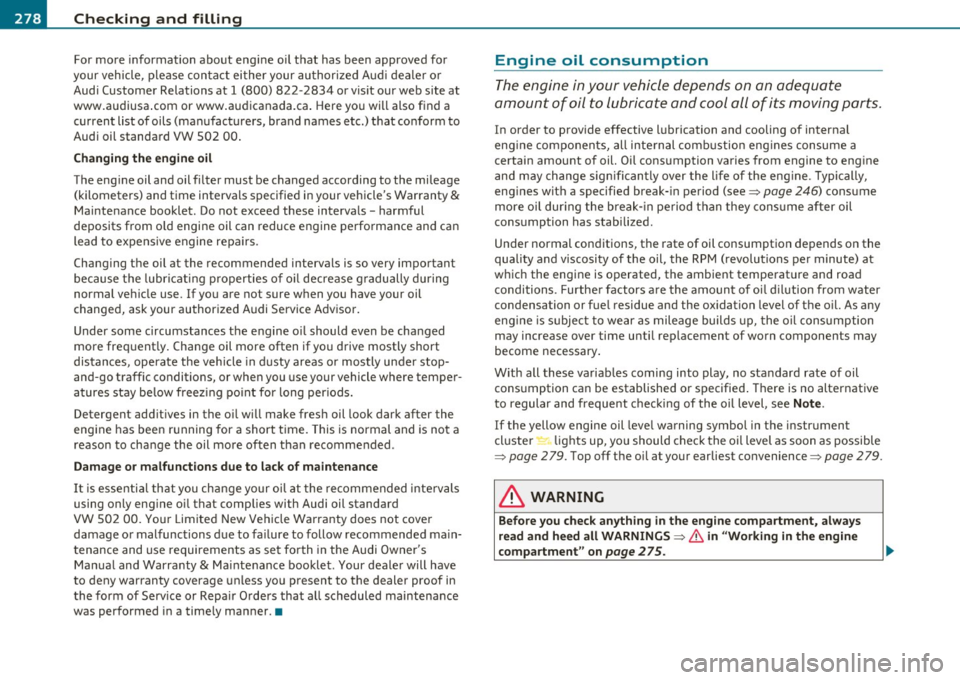
-Checking and filling
-------=----- -=-----------------------------------------
For more information about engine oil that has been approved for
your veh icle, please contact either your authorized Audi dealer or
Audi Customer Relations at 1 (800) 822-2834 or visit our web site at
www.audiusa .com or www.audicanada.ca . Here you will also find a
current list of oils (manufacturers, brand names etc.) that conform to
Audi oil standard VW 502 00 .
Changing the engine oil
The engine oil and oil filter must be changed according to the mileage
(kilometers) and time intervals specified in your vehicle's Warranty
&
Maintenance booklet . Do not exceed these intervals - harmful
deposits from o ld engine oil can reduce engine performance and can
lead to expensive engine repa irs.
Changing the oil at the recommended intervals is so very important
because the lubricating properties of oil decrease gradually during
normal vehicle use. If you are not sure when you have your oil
changed, ask your authorized Audi Service Adviso r.
Under some circumstances the engine o il should even be changed
more frequent ly. Change oil more often if you drive mostly short
distances, operate the veh icle in dusty areas or mostly under stop
and-go traffic conditions, or when you use your vehicle where temper
atures stay below freez ing po int for long periods.
Detergent additives in the oil will make fresh oil look dark after the
engine has been running for a short time. This is normal and is not a
reason to change the oil more often than recommended .
Damage or malfunctions due to lack of maintenance
It is essentia l that you change yo ur oil at the recommended intervals
using only engine oil that complies with Audi oil standard
VW 502 00. Your Limited New Vehicle Warranty does not cover
damage or malfunctions due to fa ilure to follow recommended main
tenance and use requirements as set forth in the Audi Owner's
Manual and Warranty
& Maintenance booklet. Your dealer will have
to deny warranty coverage unless you present to the dealer proof in
the form of Service or Repair Orders that all scheduled maintenance
was performed in a timely manner. •
Engine oil consumption
The engine in your vehicle depends on an adequate
amount of oil to lubricate and cool all of its moving parts.
In order to provide effective lubrication and cooling of internal
eng ine components, all inte rnal comb ustion eng ines consume a
certain amount of oil. Oil consumption varies from engine to engine
and may change sign ifican tly over the life of the engine. Typically,
engines with a specified break-in period (see~
page 246) consume
more oil dur ing the break- in period than they consume after oil
consumption has stab ilized.
Under normal conditions, the rate of oil consumption depends on the
quality and viscosity of the oil, the RPM (revolutions per minute) at
which the engine is operated, the ambient temperature and road
conditions. Further factors are the amount of oil dilution from water
condensation or fuel residue and the oxidation level of the oil. As any
eng ine is subject to wear as mileage builds up, the oil consumption
may increase over time until replacement of worn components may
become necessary.
With all these variab les coming into play, no standard rate of oil
consumption can be established or specified . There is no alternative
to regular and frequent checking of the oil level, see
Note .
If the yellow engine oil level warning symbol in the instrument
cluster lights up, you should check the oil level as soon as possible
~ page 279. Top off the oil at your earliest convenience~ page 279.
& WARNING
Before you check anything in the engine compartment , always
read and heed all WARNINGS ~
& in "Working in the engine
compartment" on page
275.